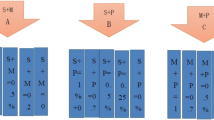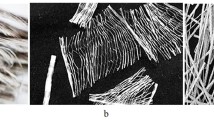Abstract
In this study, the effects of macro-synthetic fiber (MSF) ratios and various temperatures on the flexural performance of MSF-reinforced concrete were investigated. MSF-reinforced concrete was produced in the C40 strength class, which is widely used in industrial concrete applications. The effects of fiber content and temperature variations on the flexural strength and toughness of MSF-reinforced concrete were analyzed. In this context, flexural specimens were produced by replacing 0.5%, 1.0%, 1.5%, and 3% MSF by volume with concrete instead of aggregate. The specimens were tested using a four-point flexural test at a negative temperature (−5 °C), ambient temperatures (20, 50 °C), and non-ambient temperature (90 °C). In addition, pull-out tests were applied to the fibers embedded in the concrete specimens to determine the bond performance between the MSF and concrete under different temperatures. The effective MSF content for the concrete was determined to be in the range of 1–1.5% according to the results of thermal performance, bending behavior, ductility, and workability factors. Although the flexural performance of MSF-reinforced concrete decreased relatively with the temperature increase, the results were promising at certain fiber volume ratios and ambient temperatures.














Similar content being viewed by others
References
Abaeian R, Behbahani HP, Moslem SJ (2018) Effects of high temperatures on mechanical behavior of high strength concrete reinforced with high performance synthetic macro polypropylene (HPP) fibres. Constr Build Mater 165:631–638
Ahmad J, Zhou Z (2022) Mechanical properties of natural as well as synthetic fiber reinforced concrete: a review. Constr Build Mater 333:127353
Aidarov S et al (2022) Effects of low temperatures on flexural strength of macro-synthetic fiber reinforced concrete: experimental and numerical investigation. Materials 15(3):1153
Akça KI, Recep ÖÇ, Ipek M (2015) Properties of polypropylene fiber reinforced concrete using recycled aggregates. Constr Build Mater 98:620–630
Alan D et al (2018) Study of temperature effect on macro-synthetic fiber reinforced concretes by means of Barcelona tests : an approach focused on tunnels assessment. Constr Build Mater 158:443–453
Alhozaimy AM, Soroushian P, Mirza F (1996) Mechanical properties of polypropylene fiber reinforced concrete and the effects of pozzolanic materials. Cem Concr Compos 18(2):85–92
Aly T, Sanjayan JG, Collins F (2008) Effect of polypropylene fibers on shrinkage and cracking of concretes. Mater Struct 41(10):1741–1753
Ashkezari GD, Razmara M (2020) Thermal and mechanical evaluation of ultra-high performance fiber-reinforced concrete and conventional concrete subjected to high temperatures. J Build Eng 32:101621
Balouch SU, Forth JP, Granju JL (2010) Surface corrosion of steel fibre reinforced concrete. Cem Concr Res 40(3):410–414
Behfarnia K, Behravan A (2014) Application of high performance polypropylene fibers in concrete lining of water tunnels. Mater Des 55:274–279
Bei-Xing LI, Ming-xiang C, Fang C, Lu-ping L (2004) The Mechanical properties of polypropylene fiber reinforced concrete. J Wuhan Univ Technol Mater Sci Ed 19(3):68
Bentur A, Mindess S (2006) Fibre reinforced cementitious composites. Taylor & Francis
Bhat MD et al (2022) The effect of polypropylene and steel fibers on the properties of concrete at normal and elevated temperatures—a review. Iran J Sci Technol Trans Civ Eng 46(3):1805–1823
Buratti N, Mazzotti C, Savoia M (2011) Post-cracking behaviour of steel and macro-synthetic fibre-reinforced concretes. Constr Build Mater 25(5):2713–2722
Choumanidis D, Badogiannis E, Nomikos P, Sofianos A (2016) The effect of different fibres on the flexural behaviour of concrete exposed to normal and elevated temperatures. Constr Build Mater 129:266–277
Cifuentes H, García F, Maeso O, Medina F (2013) Influence of the properties of polypropylene fibres on the fracture behaviour of low-, normal- and high-strength FRC. Constr Build Mater 45:130–137
Clarke T, Ghiji M, Fragomeni S, Guerrieri M (2022) Mechanical properties of macro synthetic fiber reinforced concrete at elevated temperatures: a systematic review and meta-analysis. Struct Concr 24:1–27
Çavdar A (2013) The effects of high temperature on mechanical properties of cementitious composites reinforced with polymeric fibers. Compos B Eng 45(1):78–88
EN 14889–2 (2015) Fibres for concrete—part 2: polimer fibres—definitions, specifications and conformity (Turkish)
Gao S, et al. (2010) Comparison of the mechanics and durability of hybrid fiber reinforced concrete and frost resistant concrete in bridge deck pavement. In: ICCTP 2010: Integrated Transportation Systems: Green, Intelligent, Reliable—Proceedings of the 10th International Conference of Chinese Transportation Professionals, pp 2927–2935
Hasan MJ, Afroz M, Mahmud HMI (2011) An experimental investigation on mechanical behavior of macro synthetic fiber reinforced concrete. Environ Eng 11(June):18–23
Hsie M, Chijen Tu, Song PS (2008) Mechanical properties of polypropylene hybrid fiber-reinforced concrete. Mater Sci Eng A 494(1–2):153–157
Kakooei S, Akil HM, Jamshidi M, Rouhi J (2012) The effects of polypropylene fibers on the properties of reinforced concrete structures. Constr Build Mater 27(1):73–77
Kosa K, Naaman AE (1990) Corrosion of steel fibre reinforced concrete. Mater J 87:27–37
Mazaheripour H, Ghanbarpour S, Mirmoradi SH, Hosseinpour I (2011) The effect of polypropylene fibers on the properties of fresh and hardened lightweight self-compacting concrete. Constr Build Mater 25(1):351–358
Müller P, Novák J, Holan J (2019) Destructive and non-destructive experimental ınvestigation of polypropylene fibre reinforced concrete subjected to high temperature. J Build Eng 26:100906
Nana WSA et al (2021) Behaviour of macro-synthetic fibers reinforced concrete: experimental, numerical and design code investigations. Structures 32:1271–1286
Peng GF et al (2006) Explosive spalling and residual mechanical properties of fiber-toughened high-performance concrete subjected to high temperatures. Cem Concr Res 36(4):723–727
Poon CS, Shui ZH, Lam L (2004) Compressive behavior of fiber reinforced high-performance concrete subjected to elevated temperatures. Cem Concr Res 34(12):2215–2222
Pakravan HR, Ozbakkaloglu T (2019) Synthetic fibers for cementitious composites: a critical and in-depth review of recent advances. Constr Build Mater 207:491–518
Richardson A, Ovington R (2017) Temperature related steel and synthetic fibre concrete performance. Constr Build Mater 153:616–621
Simões T, Costa H, Dias-da-Costa D, Júlio E (2017) Influence of fibres on the mechanical behaviour of fibre reinforced concrete matrixes. Constr Build Mater 137:548–556
Sukontasukkul P, Pomchiengpin W, Songpiriyakij S (2010) Post-crack (or Post-Peak) flexural response and toughness of fiber reinforced concrete after exposure to high temperature. Constr Build Mater 24(10):1967–1974
Tanyildizi H (2009) Statistical analysis for mechanical properties of polypropylene fiber reinforced lightweight concrete containing silica fume exposed to high temperature. Mater Des 30(8):3252–3258
Topcu İB (2006) Concrete technology (Turkish). Eskişehir: Ugur Offset
TS 802 (2016) Design of concrete mixes
TS EN 12390-2 (2000) TS EN 12350-2 testing fresh concrete Ð part 2 : slump test (Turkish)
TS EN 12390-5 (2019) Testing hardened concrete—part 5: flexural strength of test specimens (Turkish)
TS EN 12620 (2009) Aggregates for concrete (Turkish)
Vrijdaghs R, di Prisco M, Vandewalle L (2017) Creep Deformations of Structural Polymeric Macrofibers. RILEM Bookseries, pp 53–61
Web Page (2021) Kratos synthetic fiber reinforcement technical brochure
Wu H, Lin X, Zhou A (2020) A review of mechanical properties of fibre reinforced concrete at elevated temperatures. Cem Concr Res 135:106117
Wu S (1982) Taylor & Francis polymer and adhesion. Taylor & Francis, Delaware
Wu Y (2002) Flexural strength and behavior of polypropylene fiber reinforced concrete beams. J Wuhan Univ Technol Mater Sci Ed 17(2):54–57
Yap SP, Johnson Alengaram U, Jumaat MZ (2013) Enhancement of mechanical properties in polypropylene—and nylon—fibre reinforced oil palm shell concrete. Mater Des 49:1034–41
Yin S et al (2015) Use of macro plastic fibres in concrete: a review. Constr Build Mater 93:180–188
Zheng Z, Feldman D (1995) Synthetic fibre-reinforced concrete. Prog Polym Sci 20(2):185–210
Funding
The authors did not receive support from any organization for the submitted work.
Author information
Authors and Affiliations
Corresponding author
Ethics declarations
Conflict of interest
The authors declare that they have no conflict of interest.
Ethical Approval
This article does not contain any studies with human participants or animals performed by any of the authors.
Rights and permissions
Springer Nature or its licensor (e.g. a society or other partner) holds exclusive rights to this article under a publishing agreement with the author(s) or other rightsholder(s); author self-archiving of the accepted manuscript version of this article is solely governed by the terms of such publishing agreement and applicable law.
About this article
Cite this article
Saribiyik, A., Degirmenci, I. & Saribiyik, M. The Effects of Fiber Volume Ratio and Temperature on the Flexural Performance of Macro-Synthetic Fiber-Reinforced Concrete. Iran J Sci Technol Trans Civ Eng 47, 2865–2877 (2023). https://doi.org/10.1007/s40996-023-01092-z
Received:
Accepted:
Published:
Issue Date:
DOI: https://doi.org/10.1007/s40996-023-01092-z




